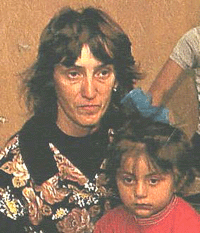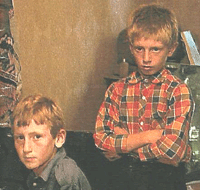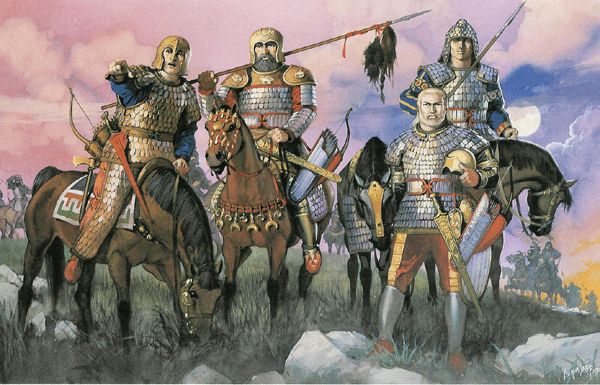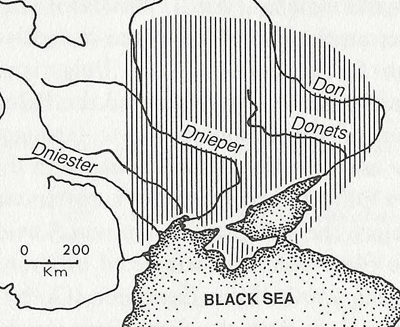Greetings to All,
Below is an e-mail forwarded to me by a friend and scholar. The forwarded e-mail is by a German gentleman who is attempting to promote pan-Turk/pan-Turan propaganda from the Grey Wolf movement that ancient Avestan-speaking North Iranian peoples were not Iranians, but of Turco-Mongol stock.
The new Grey Wolf theory now states that the cited peoples were Iranian-speaking but not Iranian (meaning Mongoloid-Turkic). You will see my humble retort below the forwarded e-mail.
All the Best
Kaveh Farrokh
====================================================
The Forwarded E-mail:
Sir,
I received the following email from a German resident,
More discoveries have been made on the Scythians by German, Russian and Mongolian archaeologists but they finally summed up on their origuins and you won’t like it:
The Germans say that the Scythians were Mongols, and some of them had Blond hair and blue eyes, hinting that the Grey Wolves-Turks were right about their origins ie that they were Turko-Finnnish people speaking the langauge of the Persians, because they were the superpower of that time but had no coonection to them
====================================================
Retort by Kaveh Farrokh:
Greetings Sir,
I would not honestly worry about this e-mail at all.
(1) Which “German” researchers is he referring to? German Professor Rolle, who has produced the latest book on the Scythians, affirms the Iranian origins of the Scythians. It appears that there is some mis-quoting or distortion being made by the e-mail sender.
(2) As per the “Mongoloid” features – what region are we referring to? The Kurgan region finds and reconstructions (see examples in Renfrew and Mallory) firmly place the Scythians of the Ukraine and the Caucasus as Indo-European with NO Mongoild features. The Cavalli-Sforza studies also have proven that no Turkic-Mongoloid peoples were present on the Steppes during the Andronovo (Sintasha-Petrovka)-Kurgan-Iranian transition eras. It is true that the eastern Scythians resident in Western Mongolia by Mede- Achaemnid times were close to the Tien Shan Mountains had Mongoloid admixtures as they neighbours of the proto-Turkic-Mongoloid peoples (The Hsiang-Nou confederation came over a 1000 years later and the word “Turk” came in the AD era with first references seen in Chinese sources. But we are looking at the extreme east of Eurasia – how does this apply all across to the Ukraine and Central Europe?
In any event, I can list a handful of the plethora of sources (see further below) that affirms the Iranic basis of the Saka/Scythians. Contrary to what the German e-mail sender has stated – Russian, Ukrainian, Polish and western scholars have overwhelmingly rejected these theories: modern scholarship overwhelmingly attests to the Iranian origin of the aforementioned peoples. Interesting how the e-mail sender has provided you with no references.
The fact that Northern Iranian peoples spoke Iranian languages is an established academic fact – even the Grey Wolves have been forced to acknowledge this. What;s interesting is that they are now stating that “they spoke Iranian languages but were Mongolian-Turkic in stock”. This is the same argument they use towards the Iranian-speaking Kurds as well as the Tajiks.
The descendants of the North Iranian peoples, the Ossetians (see National Geographic photos below), speak an old North Iranian language (Ir-On and Digor) related to Persian and Kurdish. Turkish has no linguistic connection to modern Ossetian (I am partly of Ossetian descent):
 ]
] 
These certainly do not look “Mongoloid” – and neither did my Ossetian ancestors (who did not speak Turkish at all before they fled Czarist-Soviet Russia to Iran’s Azarbaijan province).
“Ossetian” (by the way) is a term of Russian and Georgian origin. The Ossetians refer to themselves as Ir-On a variation of the term Ir-An (land of Aryans). Ir and/or Eire are the old Iranic, Indic and Celtic designations of Aryan (Noble, Lord). Ossetian historians, who acknowledge their Iranian heritage, explain their migration to Northern Georgia as a tactic of survival in the face of multitudes of Turkish, Hun and Mongol conquests that rummaged across Eurasia over the centuries.
Many of these Northern Iranians escaped and/or migrated to Persia and Europe to avoid annihilation or extermination at the hands of Turkic, Hun and Mongol invaders over the centuries. Their descendants live in Iranian Kurdistan (known formerly as Ard-Alan), Luristan (Sak-Vand) and Seistan (Saka-istan). None speak any Turkic languages nor bear any affinities to Asiatic Turkic peoples.
Genetic studies of Ossetians place them firmly in the Indo-European family. A landmark study is that by the Richards team
The Persian Shahnama epic of Firdowsi recalls the Northern Iranian legends, and the desperate battles fought against the Turkic-Hun-Mongol invaders.
The original Turkic invaders were Asiatic, very similar to the Uralo-Altaic inhabitants of modern Korea, Northern China, and Japan (see Barnes). In contrast to the ancient Turks, The Northern Iranians (see reconstruction by Angus McBride Below see Newark in references) are described by western scholars as follows:
- Scythians and Sarmatians were of Iranian origin[John Channon & Robert Hudson, Penguin Historical Atlas of Russia, 1995, p.18]
- Indo-European in appearance and spoke an Iranian tongue which bought them more closely to the Medes and Persians[Tim Newark, Barbarians, 1998, p.6]
- The Sarmatians spoke an Iranian language similar to that of the Scythians and closely related to Persian[Richard Mariusz & Richard Mielczarek, The Sarmatians: 600 BC-450 AD, 2002, p.3]

Western scholars examining the anthropology, archaeology and linguistics of the Scythians/Saka, Sarmatians and Alans have long since determined their membership as being firmly within the Iranian family (see Abaev, Bachrach, Brzezinski, & Mielczarek, Melyukova, Sulimirski). The late professor of Sarmatian and Alan studies, Tadeusz Sulimirski (1898-1983) stated that:
[the Northern Iranians were] of Indo-European stock belonging to the Iranian group, often called the Scythian group of peoples they were akin to the ancient Medes, Parthians and Persians. Their language was related to that of the Avesta [Tadesuz Sulimirski, The Sarmatians, London: Thames & Hudson, 1970, p.22]
The Avesta is used in Zoroastrian prayers, and is the ancestor of modern Ossetian. The river names, Don, Donets, Dnieper and Dniester are all of Iranian origin (see P.J. Mallory; Mallorys map on p. 78 shown below):
Don/Danu = Water, River Dnieper [Dana Apara] = the upper (old North Iranic = Apara) River Dniester [Danu Nazdaya] = the near (old North Iranic = Nazdaya Persian Nazdeek) River
The closest relative to the Iranic Don/Danu is the Celtic Danuvius, whose modern name is known as the Danube in Western Europe. Roman emperor Marcus Aurelius also settled Sarmatian warriors in Britain (e.g. modern Chester), where their Iranian mythology and culture appears to have influenced much of the local Celtic folklore (see Littleton & Malcor and Rankin).

Many Iranian words can be found in Slavic languages; either because they are both of the Satem branch of Indo-European languages or because of a long period of Iranic ascendancy on the steppes (see Gamkrelidze & Ivanov). Persian style words persist in many Slavic languages; examples include Mokry (wet) and Bogh (God). Much of the Slavic counting system is similar to modern Persian.
The corroboration and confluence from multiple domains of scholars hailing from different nationalities, is to say the least, overwhelmingly conclusive. The sender may wish to consult the recently published book on European cavalry entitled Vsadniki Vojny. Kavalerija Jevropy that was just published. That study provides further corroboration for what has been known in reputable scholarly circles: that the Persians, Medes, Scythians/Saka and Sarmatians share a common Iranic origin. As the proverbial expression goes, the case is closed.
The sender of the e-mail is not a professional academic and appears to be a dabbler and reader of popular history books. Can he read any ancient languages and has he ever engaged in archeological research?
The sender also appears to lack understanding of radio-carbon dating and he obvioulsy has not seen the most recent published findings of Rolle. “Mongoloid features” (in the way he has described it) means very little in academic terms actually – it is the genes that complete the puzzle (recall Cavalli-Sforza, etc.).
However I am concerned with the gentleman referring to the Grey Wolves as a source. These are not an academic institution – they are a racist political movement that has been attempting to revise world history since the 1920s (and much earlier). The Grey Wolves claim a Turco-Mongol basis for ancient diverse civilizations such as Anatolia-Greece, Rome, Sumeria, Egypt, China and even Persia. Apart from a few select circles, these ideas have very little academic basis – or merit.
The standard textbook for Turcocentric historical revisionism is Professor Silahi Dikers 864 page And the Whole World Was One Language – Ten Thousand Years of the Turks (see Silahi Diker’s book in references and website in web references) (Professor Silahi’s photo below). The professor’s response to challenges to his theories and “evidence” is that:
all past (non-Turkish) research pertaining to the above has been “prejudicial”, “biased” and “anti-Turkish
 Â
Â
Professor Silahi Diker
[email protected]
According to the distinguished Professor s logic, research and history that fails to support Grey Wolf ideology is by definition “anti-Turkish”
The Professor himself denies that he is motivated by any form of nationalism. You may wish to refer to Professor Diker s website for an insight into his beliefs. One quote from Professor Diker s website is revealing:
Indeed, I have proven that the culture of 6300 B.C. Anatolia as discovered at atal?? by archaeologist James Mellaart is Turkish, and since this almost 8300 years old culture was not created in a day, we can easily talk of a Ten Thousand Years of the Turks …
What Dr. Diker and other Grey Wolf activists are doing is nothing new; Soviet “historians had engaged in this type of “academia” since the 1920s.  Grey Wolves have learned a great deal from (discredited) Stalinist-era Soviet scholarship:
If history fails to support your ideology, then all you need to do is to re-write that history to fit your beliefs.
Unfortunatley, the writer of the e-mail to you has been swayed by these types of narratives. I wish him well.
I hope this helps…
Cheers
Kaveh Farrokh



